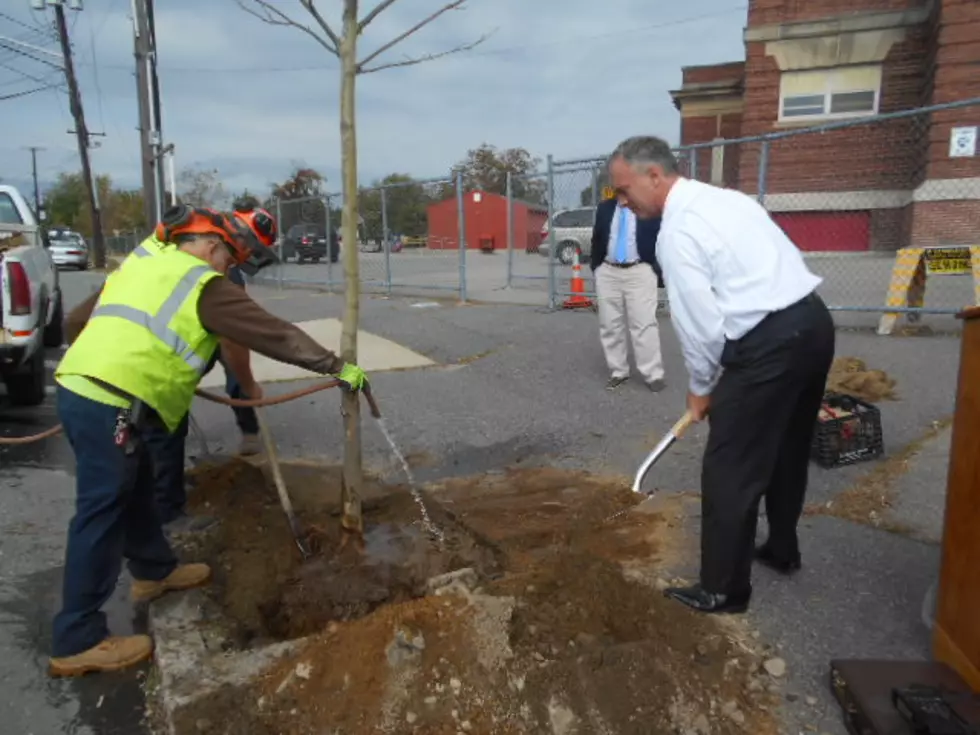
New Bedford is Planting Fewer Trees in Recent Years
UPDATE: A statement from the New Bedford mayor's office notes that the state-run "Greening the Gateway Cities" program is split between 80% private and 20% public ground for planting trees.
Although the program's goal for planting trees on public ground was exceeded, slow uptake on private property has resulted in a lower number of trees planted overall under this particular state program.
"The city itself plants 200 trees a year, and the mayor announced previously in April during his State of the City address the planting of another 1,000 trees in the next two years using federal relief funds," the statement noted.
Under the city's own initiatives, New Bedford has in fact planted 2,742 trees since 2016.
This number includes the 1,254 planted as part of the state program as well as those planted as part of construction projects and the Adopt-A-Tree program, among other initiatives.
According to data provided by a city spokesperson, from 2020-2022 the city planted just 691 trees — fewer than the 700 trees planted in 2014 alone.
Over past three years the city has planted an average of 230 trees each year, less than half the 513 per year average from the four years prior to 2020.
NEW BEDFORD — A statewide initiative aiming to add greenery to urban landscapes has seen thousands of trees planted in former industrial centers known as 'gateway cities' — but it seems New Bedford is falling behind other SouthCoast cities.
New Bedford joined the "Greening the Gateway Cities Program" in 2016, when the state invested more than $12 million to plant 20,000 trees in eight cities including Brockton, Lawrence and Lynn.
Under the program, residents in the city's designated "planting zone" — the area deemed to be most in need of greenery — can get trees planted for free.
New Bedford's planting zone is in the North End, stretching from Coggeshall Street/north of 195 to a few blocks north of Brooklawn Park.

How has the planting been going so far?
Since 2016, 1,254 new trees have been planted in New Bedford thanks to the program, with 585 trees planted on public land and 669 on private property, according to an update provided by the state's Department of Conservation and Recreation.
That's about half of the city's goal of 2,400 trees, according to the program's website, which also shows that 1,149 of New Bedford's trees were planted as of December 2021 — meaning only 105 trees have been planted since last year.
Mass DCR stated the project in New Bedford is ongoing, but due to the extreme drought this summer, it was put on hold to avoid putting more pressure on local water resources.
Tree planting can now resume, as the drought conditions have been reduced to a Level 1 or 'mild' drought, according to the department.
A DCR position for a "seasonal planting laborer" paying $16 per hour was being advertised on the MassCareers job website until it was taken down on Oct. 19, perhaps indicating that the job has been filled.
Work on planting trees is expected to go through November.
A spokesperson for the city of New Bedford noted that under its own initiatives and programs, the city has in fact planted 2,742 trees since 2016.
This number includes the 1,254 planted as part of the state program as well as those planted as part of construction projects and the Adopt-A-Tree program, among other initiatives.
How does New Bedford compare to other cities?
According to the program website, Fall River last year reached 2,936 trees planted while Brockton planted 2,570 trees, both exceeding their 2,400-tree goal.
On Aug. 29, Fall River was just awarded another $99,125 to plant 175 more trees on city streets.
Meanwhile the city of Taunton has just joined the program this year, and last week was awarded a $60,000 grant to plant 2,500 trees and purchase a 500-gallon truck-mounted spray tank as well as tree planting equipment.
Funding will also go towards hiring a contractor to construct new tree pits along city sidewalks, according to an Oct. 12 release from the city.
New Bedford, on the other hand, has been awarded $15,000 to raise awareness of the tree-planting program, including social media activities, door-to-door canvassing and spreading brochures on the program in the planting zone.
How to plant more trees in New Bedford
Residents and business owners within the city's North End planting zone can ask for free trees to be planted on their properties through the program website.
Tenants can apply with written permission from the property owner, according to the site's FAQs.
Urban foresters will then schedule a site visit to determine how many and what types of trees to plant.
Those who get free trees must agree to water them for two years.
The Greening the Gateway Cities Program aims to increase the number of trees in urban areas in Massachusetts by planting 6-10 foot tall trees that will cover 5% of target neighborhoods with a tree canopy.
Trees help clean the air of dust and pollutants, cool summer temperatures, and reduce noise in neighborhoods, as well as helping raise property values and reduce crime.
A 2021 study in the journal PLOS ONE found that the U.S. Northeast has the greatest disparity in tree cover between low- and high-income neighborhoods.
Researchers said some low-income blocks had 30% less tree cover and were around four degrees Celsius hotter than high-income areas in the northeastern U.S.
The Spookiest Legends of the SouthCoast
More From WBSM-AM/AM 1420








![Fall River Terrier Needs a New Place to Call Home [WET NOSE WEDNESDAY]](http://townsquare.media/site/519/files/2024/07/attachment-Untitled-design-2024-07-24T061926.621.jpg?w=980&q=75)
